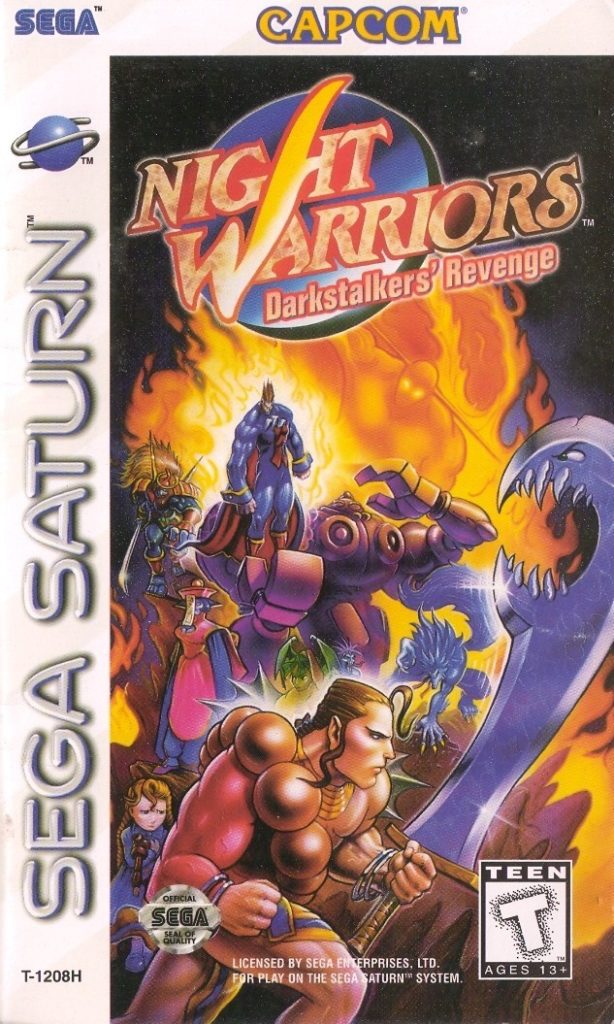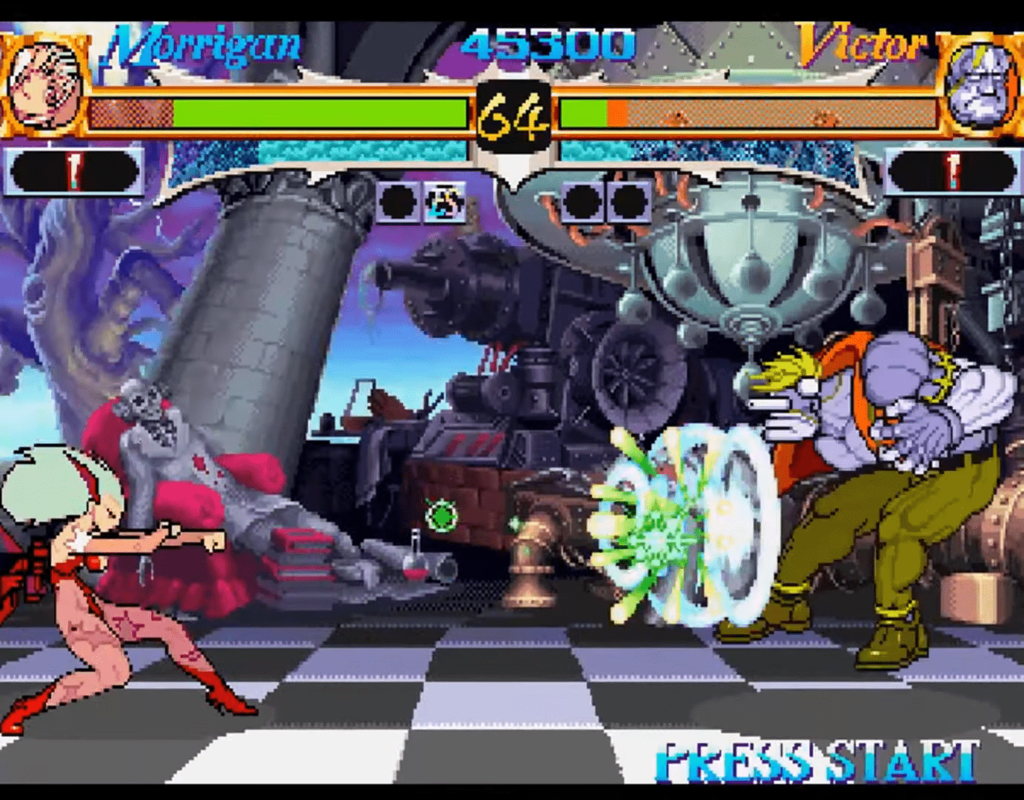I can’t talk (at length) about SF2 and its many editions, without also covering the Capcom fighters that were basically SF2 in disguise – Darkstalkers, Marvel Super Heroes, Street Fighter Alpha, X-Men vs Street Fighter, Marvel vs Capcom… I played the hell out of all of them. Compared to the rest of the Street Fighter II timeline, 1995-1997 were some pretty busy years for fans of Capcom fighters –
- 1991
- February 15 – Street Fighter II (arcade)
- 1992
- March – Street Fighter II: Champion Edition (arcade)
- July 15 – Street Fighter II (SNES)
- December 21 – Street Fighter II: Hyper Fighting (arcade)
- 1993
- August 1 – Street Fighter II Turbo (SNES)
- September 11 – Super Street Fighter II (arcade)
- September 28 – Street Fighter II: Special Champion Edition (Sega Genesis)
- 1994
- February 23 – Super Street Fighter II Turbo (arcade)
- July – Darkstalkers (arcade)
- July 18 – Super Street Fighter II (SNES/Genesis)
- 1995
- January 5 – X-men: Children of the Atom (arcade)
- April 6 – Night Warriors: Darkstalkers’ Revenge (arcade)
- June 27 – Street Fighter Alpha (arcade)
- October 24 – Marvel Super Heroes (arcade)
- 1996
- February 22 – Night Warriors (Saturn)
- March 6 – Street Fighter Alpha 2 (arcade)
- April 6 – X-Men: Children of the Atom (Saturn)
- June 6 – Street Fighter Alpha (Saturn)
- September – X-Men vs Street Fighter (arcade)
- November – Street Fighter Alpha 2 (Saturn)
- 1997
- March – Street Fighter III (arcade)
- March 28 – CyberBots (Saturn)
- August 8 – Marvel Super Heroes (Saturn)
- August 27 – Marvel Super Heroes vs Street Fighter (arcade)
- September 30 – Street Fighter III: Double Impact (arcade)
- November 27 – X-Men vs Street Fighter (Saturn)
- 1998
- January 23 – Marvel vs Capcom (arcade)
- October 22 – Marvel Super Heroes vs Street Fighter (Saturn)
- 1999 – Street Fighter III: Third Strike (arcade)
- 2000 – Marvel vs Capcom 2 (Dreamcast)
Released just a few months after Super Street Fighter II Turbo, Darkstalkers might’ve been my favorite out of the Capcom’s many Street Fighter re-skins. In terms of gameplay, Darkstalkers didn’t re-invent the wheel at all – if you played Street Fighter II, you could jump right into Darkstalkers. The main draw to Darkstalkers was its entirely new cast of characters, largely inspired by classic movie monsters, rendered with colorful, highly-animated sprites. Perhaps because its gameplay was nearly identical to SF2 – and because SSF2T was still a major draw – my local arcade never gave it a prime position. While the likes of SSF2T and Mortal Kombat II enjoyed spacious areas near the middle/front of the arcade, Darkstalkers was tucked into the back corner, where it would mostly only be noticed by kids like me who didn’t have time to wait for their turn to play (and be beaten at) the more popular fighting games.
Darkstalkers was even one of my primary reasons for wanting a Sega 32X when it was announced, because Capcom was reportedly working on a port. That port never materialized, and the 32X ended up being one of the biggest disappointments in gaming history, to put it mildly.
Several months after Darkstalkers, in January of 1995, X-Men: Children of the Atom was released in arcades. Like Darkstalkers, the game featured highly animated, brightly-colored sprites that suited the comic book characters very well. That the X-Men animated series was still running at the time likely helped the game, as well.
Unlike Darkstalkers, X-Men used Street Figher II’s gameplay more as a template. It still felt like SF2, but it added super jumps and air-combos, and the stages were HUGE.
At this point, I’m not sure where I first saw X-Men COTA in action. My local arcade never had it. I only remember being disappointed by the game, because by that point other, faster entries were available. X-Men just felt clunky. It’s entirely possibly I hadn’t played it in the arcade at all, but instead rented it for the Sega Saturn once that version was available. By then Marvel Super Heroes had already been in arcades, and I probably thought that X-Men was the next best thing at home.
In the summer of 1995, I turned 16, and got my driver’s license. That new level of freedom meant that I could hang out with my friends – who all lived miles away – outside of school, and I could visit the mall – and its arcade – almost any time I’d wanted. The only problem was that by then, the arcade at the mall had closed. Luckily one of my friends knew of another arcade not far from there, which became one of our regular haunts. The first time we went there, Marvel Super Heroes was the latest & greatest fighter on the market, and it was a sight to behold – rather than a standard CRT, the game used a large rear-projection screen, with the controls placed a few feet in front of it.
MSH attracted a crowd and dominated the immediate area, to say the least. With faster & tighter gameplay than X-Men: COTA, plus the randomness the use of the Infinity Gems added, players would compete to see who could knock out the most devastating air-combos… and we would all have our asses handed to us by The Pro, whenever he was there.
That might’ve been how I played Street Fighter Alpha for the first time – its machine was against the wall not far from MSH, but it never drew a crowd like MSH did. That meant I could play it without waiting in line, and I didn’t need to risk being swiftly defeated by The Pro.
Night Warriors on the Sega Saturn was something special, not just because it was one of my favorite games, but for what it represented – up to that point, home ports were always downgrades from the original arcade games. Smaller sprites, less animation, fewer colors, worse sound, fewer things moving on the screen… You always had to accept something that was “close enough”, no matter how much it paled in comparison to the arcade. That is, until Night Warriors.
The home version of Night Warriors was pretty much perfect. It looked, sounded, and played like the arcade game. Not “close enough” – it was spot-on. Reviewers for Electronic Gaming Monthly and Game Fan would point out that the characters had fewer frames of animation – unless two players chose the same character – but I can’t say that it was noticeable. As far as I was concerned, the game was a flawless port.
The Saturn was the system to have, if you were into 2D fighting games. Street Fighter Alpha 1 & 2 were again perfect ports. X-Men: Children of the Atom felt clunky, mainly due to its slower gameplay. If you had a sharp eye, you might’ve even noticed the missing animation frames on each character. Marvel Super Heroes was another perfect port, with the use of an optional memory expansion cartridge. X-Men vs Street Fighter required an 8 MB expansion cart, but if you were a fan you’d happily pay the extra price to have an arcade-perfect port at home. 2D fighters were perhaps the one area where the Saturn blew the Sony Playstation out of the water.
…of course, by the time X-Men vs Street Fighter was released, if you wanted the game you had to import it from Japan. Even before then, you had to import most of the Saturn’s good games. The system was such a flop in North America, the game publishers just didn’t see any point in translating and releasing titles.
The home version of X-Men vs Street Fighter also felt like a nail in the coffin for arcades… New arcade games in general weren’t being released as frequently as they had before, likely due to the growth of the home market with the Playstation. Crowds at the arcade were also getting fewer. Not to mention, but that point the amount of time between the arcade and home releases was getting short and shorter.
In hindsight, it seems fitting – poetic, even? – that the age of the video arcade happened to end around the same time that I reached adulthood.
I started college in the fall of 1998, and from that point forward, I had little time to venture out to find an new arcade. I was in a new city, and many of my classmates weren’t from the area, either. The school did have a Marvel vs Capcom machine and perhaps one other game in its student lounge, and that was about the extent of my arcade gaming for the next couple of years. MvC hardly ever went unplayed – we were all nerds, geeks, and gamers, after all – but playing it between classes just wasn’t the same compared to having hours to waste at the mall.
Something that was equal parts depressing and exciting, was a chance encounter with an arcade owner at a shopping center near my apartment, shortly before I’d graduated college. He and an employee were unloading a new machine from a truck, while I was grocery shopping. Out of curiosity, I asked if they happened to sell older games. The manager/owner didn’t hesitate to ask what I was looking for. When I said “something like Street Fighter II”, he told me to follow him.
The storage area behind the arcade dwarfed the arcade itself, and it was so packed with games that it was difficult to navigate. In the middle of all of those machines, was Street Fighter II: Hyper Fighting. It was exactly what I was looking for! And for just $250, they offered to replace the screen and deliver it to my apartment!
At some point between graduation and landing a job, I would convert that SF2 machine into a M.A.M.E. cabinet that could play far more games. After landing a job, moving the cabinet into my new apartment wasn’t much fun, as I was on the second floor. There, it mostly just took up space in a corner. Moving it out a couple of years later was worse. For the next 10 years or more, it collected dust in my parents’ garage. I’d finally gotten around to selling it when they decided to put their house on the market, because moving that cabinet anywhere else just to have it collect more dust sounded insane.
Now, I look at the half-sized cabinets from Arcade 1-Up, and smile, but I would never consider buying one. Apart from the cabinets being too small, and space being a commodity, I think having an arcade cabinet now would be a depressing reminder of a time and place that is long gone. The feel of the arcade – the variety of games, the mixture of sounds, the social aspect – just can’t be duplicated at home. Just thinking about it makes my heart ache…


